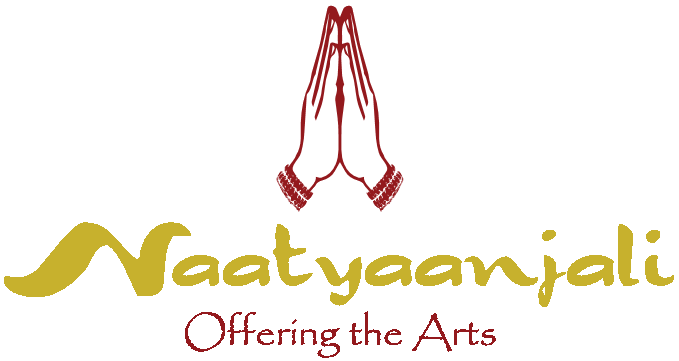Paadha Bhedhas (leg positions)
The following describes the different paadha bhedha (leg positions) that are used in Bharathanatyam. They are mainly categorized into Mandala Bhedha (standing positions with hand gestures), Shtaanaka Bhedha (simple standing positions), Utplavanas (leaps), Bhramari (circling movements / turns), Caari (movements) & Gatibhedha (gaits).
Mandala Bhedha – Standing positions with hand gestures
- Sthaanakam: Stand with feet together (Samapaada) and hands on hips with ardhachandra hasta
- Aayatam: Stand with feet half a cubit from each other in a square position with knees bending alittle apart
- Aalidham: Left foot facing front & right foot perpendicular to it, Shikara on left hand and Katakaa mukha on right hand
- Prenkhanam: Put one foot at the side of other on heel and with kurma hands
- Preritam: Put one foot violently on the earth at a distance of about 3 feet from the other, Stand with knees bent, Left hand in Shikhara hasta near chest and right hand in Pathaaka hasta stretched out
- Pratyaalidham: Hands and legs are interchanged in the Alidham position
- Swastikam: Right foot is put across the left foot, Right hand is put across the left hand
- Motitam: Sit in muzhumandi(full sit) and touching the earth with each knee alternately, Tripataka hasta on both hands
- Samasuchi: Earth is touched with both knees and toes
- Paarshva suchi: Muzhumandi where the earth is touched with toes and by one knee on one side
Sloka:
Sthaanakam Cha Aayatha Aalidham Prenkhana Prerithaani Cha
Prathayaalidham Svasthikam Cha Motitham Samasuchikaa
Paarshvasuchithi Cha Dhasha Mandalaani Rithaaniha
Shtaanaka Bhedha – Simple standing positions
- Samapaadam: stand with feet together
- Eka Padam: stand on one leg. Place the other leg on the knee of the leg that is standing
- Nagabandham: in aramandi position with the right on toes in front of left, touching the ankle of the other leg
- Aindhram: in aramandi position, raise one leg and place it on the knee of the other; hands hanging naturally
- Garudam: place right leg in front and bent at knee, left is stretched out behind on toes; both hands in dola stretched above the head
- Brahma paadam: Padmasana (commonly known as the lotus position in yoga)
Sloka:
Samapaadham Cha Ekapaadam Naagabhandhas Thathah Param
Aidhram Cha Gaarudam Chaiva Bharmasthaanam Edhikramaath
Utplavanas – leaps
- Alaga: leap forward in aramandi and land in aramandi; open both hands from chest level to above head to shoulder level in shikara
- Katari: leap to the side, ending with toes of one leg in front of the other; both hands in katarimuga
- Asva: leap forward with right and left legs and and with bent knees before straightening them; left hand on waist and right hand in tripataka depicting a horse
- Motitam: leap to the side, ending with toes of one leg behind the other; ending position right hand stretched at shoulder level in alapadmam and left hand above head in shikara
- Kripalaga: leap forward and land in aramandi; ending position right hand out in front in alapadmam and left hand above head in shikara
Bhramari – circling movements / turns
- Utpluta: Leap with both feet in the air and make a full turn
- Cakra: Make a full turn with one leg stretched out on toes (right hand stretched at shoulder level in alapadmam and left hand above head in shikara) then continue the turn with the other leg stretched out on toes (alternate the hands)
- Garuda: Make a full turn with one leg off the ground like hawk / eagle
- Ekapada: Turn with one leg placed across the knee of the other
- Kuncita: Turn in aramandi, with one leg placed across the knee of the other
- Akasa: Make a full turn in a star-jump like manner
- Anga: Rotate the whole body in a full circle while in Preritam position
Caari – movements
- Calana: Walk with feet flat on ground
- Cankramana: Walk and place heel then feet flat on ground
- Sarana: Feet flat on ground, move with toes
- Vahgini: Run forward in small steps
- Kuttana: Move back on heel
- Luthita: Lift leg with knee bent and bring towards yourself, then place on floor with heel then flat
- Lolita: adavu used in pancha nadai
- Visamasancarah: place right leg in front of left then left in front of right; continue in a snake-like movement
Gatibhedha – gaits
- Hamsi: swan movement
- Mayuri: Peacock movement
- Mrgi: Deer movement
- Gajalila: Elephant movement
Note: The distinctive feature in Bharathanatyam is its basic stance or the posture called the Araimandi or the half-sit position. It is important that one masters this as most part of the dancing is carried out in this position.
Anga shuddhi (clean lines) are achieved when the Anga, Pratyanga and Upaanga is in unison. Anga means body parts and Shuddhi means perfection or purity. The Natya Sashtra has slokas describing how to perform the movements.

